Throughout skiing’s history, consumers have grown accustomed to certain kinds of equipment, and of course, trends have developed and shifted around as technology advances, and the sport becomes more popular. Whether it was the rise of parabolic shaped skis in the early 1990’s, or the popularization of fat powder skis soon after that, there’s no doubt that skiing is a sport whose gear is no stranger to rapid progression. Over the past ten years, a new approach of custom ski design has slowly emerged, and it’s proven to have great versatility and go much further than traditional concepts. Experience the difference a pair of custom skis can make for you.
Beyond just the product itself, owning and riding a pair of custom skis is just as much about the overall experience. Taking part in the design and construction process gives a skier confidence in knowing that his or her equipment is exactly what they need to be the best skier possible, despite ability or comfort levels wherever they might be skiing. Sure, someone who’s dedicated to their research can dive into gear reviews and buyer’s guides in order to figure out what they need under their feet, but in the world of standard ski manufacturing, there’s only so many variables that can be isolated from ski to ski, and it’s impossible to please everybody. Instead of adapting your skiing to what’s available on the market, why not have your skis be build around your personal style of skiing? At the end of the day there’s no substitute for being able to adjust attributes such as camber, stiffness, and composites such that they’re tailored uniquely to you. That’s the difference of a custom ski.
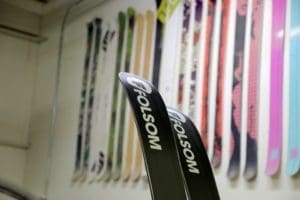
Custom skis are for everyone. Whether you’ve never skied once before, or you’re a seasoned veteran of the hill, anyone can genuinely benefit from using custom skis. As a member of either category, one might think about what they want to get out of their skis. What’s their purpose? What are your goals as a skier and how can your skis help get you there? If you’re a beginner skier who wants to progress quickly and open up more terrain opportunities, perhaps a certain geometry will benefit you most. If you’re an expert resort skier who’s interested in exploring the backcountry with a lightweight setup, but not sure where to start, perhaps a certain composite makeup will allow that. Do you love the shape of your current skis, but wish they were just a bit stiffer? Scenarios like these are endless and they’re entirely possible to navigate within the world of custom skis. Paired with a skier’s physical attributes, these objectives will only enhance the custom design process and will allow you to get the most out of your experience.
As you may expect, the custom fit process starts with some basic intel about you, the skier. Height, weight, age, and gender are first accounted for, but then our fit process looks further into your skiing to pinpoint what exactly we can learn about you to build you the perfect pair of skis. A discussion of your ski background, where you currently do most of your skiing, plus what ski gear you currently own (if any) occurs subsequently. Additionally as you progress on-snow and are in your search for the perfect ski, we want to know what you’re looking for in a ski, in whatever verbiage you’d like to use. This is what we call our experiential custom fit, which, unlike other custom ski companies’ custom fit methods, looks past just your physical attributes and allows us to truly get to know you as a skier, allowing us to to fit you onto the best pair of skis possible.
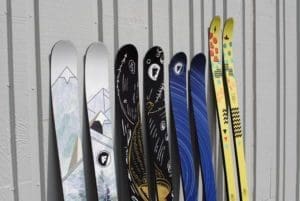
The tangible design of your custom skis is based around our experiential custom fit process, and is broken down into a number of categories. The first may go without saying, but is the skis’ shape, quantified by the length and tip-waist-tail dimensions. Different shapes (also called models) are purposed for different types of terrain and snow. For instance, a narrower ski (70-90mm underfoot) will perform better on hard snow and have stronger edge hold than an all-mountain ski (90-110mm underfoot) or a powder ski (110mm+ underfoot). On the contrary, your typical powder ski will have a harder time with edge hold and stability on hardpack, but will perform much better in softer snow. In picking the shape of your ski, consider geographically where you’ll be purposing the ski most, and which attributes you value most in a ski (stability vs. carving vs. float, etc.). The Folsom models displayed online are our best sellers and award winners, but we are capable of crafting any geometry your heart desires, or you can contact us to shop some of our older more “secret” offerings.
The next step in your custom skis’ design is the rocker / camber profile. First off: what is ski rocker? Rocker is the portion of a ski that tapers away from the snow’s surface early which makes the ski more nimble and maneuverable, and helps you plane / float up on top of softer snow (see the blue portion of this graphic). What is ski camber? Camber is the portion of a ski that counteracts the rocker and gives your skis a reactive, energetic feel (see the grey portion of this graphic). Our rocker / camber profiles cover a wide range of options from full camber, to rocker-camber-rocker, to full reverse camber, plus a handful of iterations in between. The profile we help you choose for your custom skis is again based on where you’ll primarily be using the ski combined with what traits you value most in a ski (surfy vs. grippy, poppy vs. stiff, etc.).
Folsom cores consist of varying blends of hand-selected poplar, maple, and bamboo. Each core contains a centered bamboo stringer that acts as a vibration damper as well as carbon fiber stringers strategically measured and applied on a case-by-case basis. A poplar / bamboo blended core makes for a light, playful ski, whereas the addition of maple to the poplar / bamboo blend provides additional stability, damping, and torsional rigidity for the more aggressive or heavier skier.
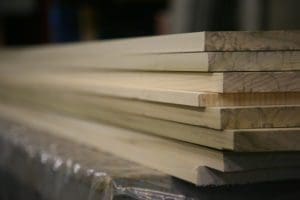
The thickness of your core is primarily determined by your height and weight as well as what level of stiffness you think you’re looking for in your ski. Each core is precision milled on our CNC machine to a tolerance of .025 mm. Simply put, the thicker the core, the stiffer the ski. Our custom builds break down into 3 core thicknesses for each material blend: soft / playful, moderate / standard, and stiff / aggressive. Each profile varies by 0.3 to 0.5 mm or about the thickness of your fingernail. Both our poplar and maple core blends multiplied through these three core thickness profiles in each of our shapes allow our cores to cover skiers of any size and skill level.
The composite makeup of a ski is an area that is commonly misunderstood. The two primary composites that are used in alpine skis are (1) fiberglass and (2) carbon fiber. While fiberglass weaves are typically a bit heavier when saturated and cured, the glass provides a damp, stable ride while bonding together components like your topsheet, core, and base materials. Carbon fiber has similar bonding and strength properties and is much lighter weight than fiberglass, but unfortunately becomes very brittle through the press and cure cycle, meaning it does not carry the optimal damping qualities of fiberglass. Every Folsom ski has a unique composite lay up that is tailored towards the ski’s intended use. Our standard glass builds use 22 oz triaxial fiberglass to create a reliable resort ski, while our full carbon builds (containing no fiberglass and only triaxial carbon fiber) make for extremely lightweight, uphill-oriented skis. Our “Lightglass” option substitutes about 30% of the ski’s fiberglass for carbon, making a great middle ground for those in search of a lightweight product without sacrificing downhill performance.
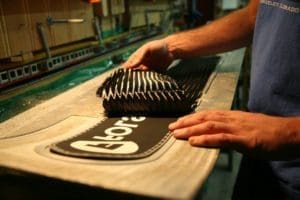
The final construction attribute of your custom ski is the ski’s tail shape. Tail shape depends primarily on a skier’s style and has less of an effect on a ski’s performance than it does on the ski’s aesthetic. A freeride oriented skier would typically prefer a round tail for better switch (backwards) maneuverability, while a frontside / carving oriented skier would likely prefer a flat tail that sits a few millimeters closer to the snow. Of course a swallowtail is best for a surf-inspired, deep snow ride. As stated, the effects of a ski’s tail shape are often difficult to recognize by feel, but instead provide the skier with a the aesthetic they’re looking for.
Last but not least, and for many the most important piece of a custom ski is the custom ski graphic. Referred to as the topsheet graphic or design, this is the portion of the ski that is on display during every part of your ski day (unless it’s waist deep pow). There are many different types of topsheet materials, thus there are many different ways to achieve a custom topsheet depending on what material is being used. The most common method is the process of dye sublimation. Since printing directly onto the gritty, durable topsheet material would be difficult, topsheet graphics are printed from a dye-sub printer onto a transfer sheet. This transfer sheet is then laid directly on top of the topsheet material, then under heat and pressure, the ink goes through a sublimation cycle (the phase change from solid to gas), ultimately being completely transferred into the topsheet material in about 10 minutes. Folsom’s topsheet graphic offerings cover a wide variety of subjects, and all are fair game for any custom build at no extra cost. If you want your skis to truly stand out, we are happy to add in things like initials, emblems, and company logos, or we can build you a completely unique graphic from scratch.
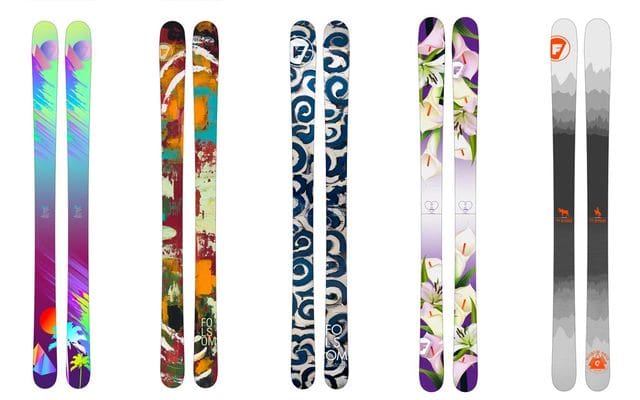
Once you’ve had a discussion about your ski design and mapped out each individual aspect, it’s time to build the actual skis. The entire build process for one pair of skis can take anywhere from 8-12 man hours, depending on what methods and materials are used. However, this doesn’t mean that you should expect to have your skis a day after you order them, most manufacturers group together a handful of skis at a time in order to isolate each step of the build process for that group. This allows the folks building your skis to really take their time and pay attention to what they’re doing, rather than just trying to crank out as many units as possible to meet a certain figure. Additionally, this allows for more non-automated build methods such as hand wrapping edges or hand planing cores which can add to the build quality and life cycle of a ski. Part of the beauty of a custom ski is that manufacturers generally employ smaller groups of highly skilled craftsman who are properly trained and have many hours of construction practice. It’s important to remember that the custom elements of your ski design are preserved throughout construction, and because of this, almost no two skis are exactly the same. Otherwise what’s the point of going custom?
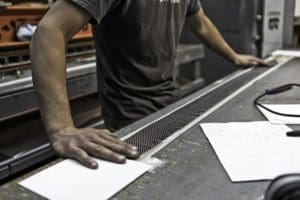
After your custom skis have been built don’t hang them up on the wall or lock them in your closet, take them skiing! Your skis have been specifically designed, engineered, and built for you, so go get to know them. An important consideration is that skis will flex, react, and generally perform differently over the course of their lifetime. Just like any new product that is not identical to the old, your new custom skis may take a few days (or longer) to get used to. Recall the characteristics that were touched on in your custom fit consultation and look to recognize those characteristics in the action of your skis. If you’re not satisfied with the product, we want to know. We stand by our products and want to you to enjoy your custom skis to the fullest extent so please give us feedback on your skis (both good and bad) once you’ve had some significant time on them. If your experience hasn’t been pleasant we’ll make it right. If, like nearly all of our clientele, you love your new skis, we’ll look forward to working with you on future builds down the road.
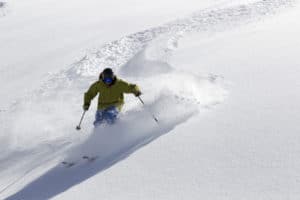
As discussed above, there’s far more that goes into a custom ski than meets the eye. The difference is in the experience, which often starts before someone even contacts a manufacturer. It’s the time taken to become involved in the design process of your own ski, as well as your individuality coming into play throughout the build process. And finally, the difference is when you feel those first few turns on your skis, knowing that you’re on the best equipment, engineered and built uniquely for you. Taking it a step further, your doing yourself a favor by putting yourself on equipment that will allow you to progress faster as a skier, despite your ability level. It’s certainly an investment, but by most accounts, one that’s well worth it. Comparing the cost of a full custom build to a brand new pair of premium skis off the rack, the price is not very far off. In fact, it’s an average of about 15% more to go the custom route, with those margins often disappearing during the summer months. Ski days can be long and tough, so do yourself a favor by at least considering a custom ski setup. Hey, you’ve read this far, why not see for yourself and start a custom ski build today.